Guanajuato city, Guanajuato 作者: 来源: 发布时间:2021-03-22
1. Basic data
Pop.: 184,239 (2015)
Area: 72.54 km2 (urban area)
Elev.: 2,000 masl
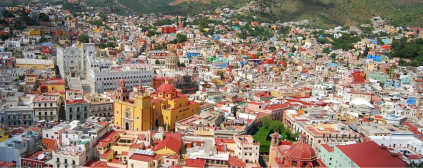
Guanajuato location
https://goo.gl/maps/AEp8yhEmEs4phHmZ7
2. Natural geography
The Michoacán–Guanajuato volcanic field is located in central Mexico, a strip of low-altitude cinder cones randomly scattered throughout the area. The most recent eruption was El Parícutin, which erupted in 1943 and was active until 1952. El Parícutin is considered a monogenetic volcano, just like others in the area, meaning that it only erupts once.
The Lerma River is a major waterway that runs through the state of Guanajuato. One of its major tributaries, the Guanajuato River, starts in the city of Guanajuato at the base of the Sierra de Guanajuato Mountains. During the mid-1900s, a dam was built in order to contain the river, which was initially underground and would often flood areas of the city.
The city is surrounded by the Sierra de Guanajuato Mountains of central Mexico and is in a narrow valley with homes and businesses built on hills and steep canyons. The city’s terrain has made roadways difficult to construct and its streets narrow and winding. Most are really alleys – called callejones – that cannot accommodate an automobile.
https://www.expatsinmexico.com/guanajuato-geography/
Weather
Two climates predominate. One is fairly hot and dominates in the south and southeast portions of the municipality. The other is temperate and dominates the rest of the territory, including the city. In the warmer areas, temperatures can reach as high as 36 °C (97 °F) in the summer and in the coldest area can get as low as 3 °C (37 °F) in the winter. Average temperature overall is 18.5 °C (65.3 °F) with an average annual precipitation of between 600 to 840 mm (23.6 to 33.1 in). Most rain falls during the rainy season between July and August.
Getting there and around
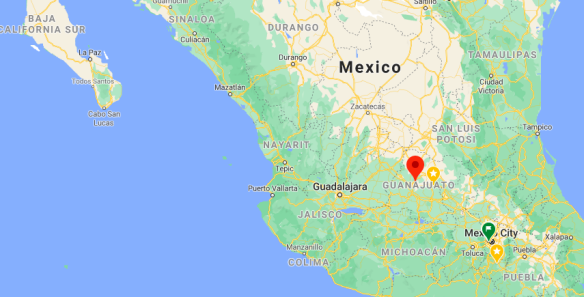
By plane
Guanajuato International Airport (IATA: BJX) (ICAO: MMLO) in Silao is the closest airport serving Guanajuato. It also serves the cities of Leon and Silao, the industrial cities of the state. National and international airlines serving this airport include:
·Aeromexico, Aeromexico Connect (Atlanta, GA; Detroit, MI:; Los Angeles, CA; Mexico City; Monterrey; Tijuana)
·American Airlines (Dallas/Fort Worth International, TX)
·Interjet (Houston, TX; San Antonio, TX; Los Angeles, CA; Monterrey, Cancun, Mexico City, Puerto Vallarta, Tijuana)
·United Airlines (Houston, TX; Los Angeles, CA)
·Viva Aerobus (Ciudad Juarez, Monterrey)
·Volaris (Chicago Midway, IL; Ciudad Juárez; Los Angeles, CA; Oakland, CA; Tijuana, Cancun).
Alternatively if you're flying from Europe, Asia, South America, or other cities in Mexico, you can fly through Mexico City and take a bus or a flight from there. There is a direct bus from the Benito Juarez Airport in Mexico City (IATA: MEX) to Queretaro where one transfers to another bus to Guanajuato with Primera Plus. Or you can take a taxi from the airport to the Central del Norte (north bus terminal in Mexico City) and take a bus directly to Guanajuato. You may also consider flying into Guadalajara and then taking a bus from there.
Transportation to Guanajuato from the Airport
The airport does not have (as of August, 2019) direct public transport to downtown Guanajuato. Taxis are available to take you to Guanajuato directly from the airport, however this is a significant distance (and cost).
There are, however, buses to Guanajuato bus station (every 2 hours) offered by Unebus (52 pesos). This takes approximately 20 minutes, but you still have about 7 km to go to get downtown.
From the Guanajuato bus station, it's possible to exit the terminal and either take the local bus to Guanajuato Center (7.50 pesos) or a taxi (60 - 80 pesos). The local bus will go through many tunnels and you will have no idea where to get off unless you ask someone. They will drop you off in a tunnel near an exit and you will need to walk a bit to downtown from there. This trip could take anywhere from 15-30 minutes depending on traffic.
By bus
Bus service in Mexico is quite reliable and comfortable. Before the recent start-up of several low cost air carriers, Bus was the main mean of transport across Mexico. Several lines serve Guanajuato including Primera plus. Buses have air conditioning (except some "economy" ones), and often show movies and have refreshments.
The main bus station is south of town, at Km 7 of the Carretera de Cuota Silao-Guanajuato (Hwy 110D) in Colonia Los Alcaldes. Deluxe and 1st-class bus tickets can also be bought in town at Viajes Frausto (+52 473 732-0115 or 732-35-80; Luis González Obregón 10; Col Centro). The following bus companies operate buses to/from here (Note: The 800 toll free numbers are for calling from within Mexico unless stated otherwise. Other numbers are regular or local numbers. From outside Mexico you will have to call the regular numbers):
·Grupo Estrella Blanca, ☎ +52 55 5729-0807 (toll free: 800-507-5500), they operate the Americanos, Elite, Elite Plus, Oriente, Chihuahuanese, TNS (Transportes Norte de Sonora) and the Pacifico brands. edit
·ETN (Enlances Terrestre Nacionales), Turistar Lujo, Carreta de cuota Guanajuato Silao Km.7 s/n Interior Central de Autobuses (bus station), ☎ +52 473 733-0289 (toll free: 800 8000-386)
·Primera Plus, Flecha Amarilla, Blvd. Hilario Medina 202; Col. Killian 1ª sección C.P.37260 León, Gto., ☎ +52 447 710-0001 (toll free: 800 375-75-87),
You can take a taxi or local bus in the city to the bus station ('Central de Autobuses' in Spanish) to catch a bus to San Miguel de Allende (1 hour), Guadalajara (3 hours), Mexico City Norte (5 hours), Acapulco, Queretaro and other locations.
Get around
By foot
Guanajuato is not very big and you can walk to most places, so a car is really not necessary.
If you arrive to Guanajuato driving a car, make sure to park your car in your hotel, most offer free shuttle to the city, otherwise, park your car in a lot (Estacionamiento in spanish) Again, your car is useless if you want to know Guanajuato.
There are lots of taxis and you should be able to get where you're going for around 2 to 4 dollars. Taxis in Guanajuato do not have meters. Instead, before getting into the cab, ask the driver how much it will cost to go to your destination.
Also, there are buses that you can ride for very cheap (Sistema Coordinado de Transporte de Guanajuato)
By tourist trolley
A trolley-like bus makes sightseeing tours of the city departing from Plaza de la Paz in the Centro, next to the Basilica of our Lady of Guanajuato. The rides lasts 1.5 hours and costs $100 pesos. There is a tour guide in Spanish only. Is a great way to know the city.
By car
Remember, driving a car is NOT an option to get to know Guanajuato. However, if you plan to get in and out of the city, then you will need to use the underground roads or tunnels, which are one of the main features of the city. The first tunnel was built in the remnants of a river in the late 1960's and new tunnels were later added to the city to speed up car traffic. The last was built around 1990. Many of the city buses run through the tunnels and it is safe to wait for them in the special underground stops. Walking in the tunnels near Centro (downtown) is also safe. If you're driving, take into account that the tunnels are one way only, so taking the wrong tunnel may result in making a big tour around all the city. Parking can be extremely difficult, there are official lots which cost about M$15/hour downtown and M$6-8/hour on the outskirts, nightly, weekly and monthly rates are not common (you can ask), so those hourly fees can quickly add up.
Current tunnels:
·El Barretero Runs west-east, southeast of the city and connecting the neighborhood near Presa de la Olla.
·La Galereña Runs north-south, south of the city and is an exit of the city.
·El Minero Runs east-west, in Centro.
·Tunel Noroeste Ponciano Aguilar Runs east to west, northeast of the city.
·Tunel de los Angeles Runs west to east, south of the city and is an exit of the city.
·Santa Fe Runs east to west, northwest of the city.
·Miguel Hidalgo The longest of all tunnels. Runs west to east, across the city.
·Tamazuca The only two-way tunnel and the shortest also. Runs north to south and viceversa, west of the city.
https://wikitravel.org/en/Guanajuato
3. Economy
The GDP in 2009 was of 986.4 millions of USD.
https://portalsocial.guanajuato.gob.mx/sites/default/files/documentos/2010_SDE_Indicadores%20del%20Municipio%20de%20Guanajuato%202010.pdf
4. Industry
There are two clear trends related to the productive vocations of the municipality, on the one hand, the sustained growth of the employed population belonging to the service sector, as well as its percentage reduction in the employed population in the primary and secondary sectors. From 1990 to 2010, the population of localities with less than 2,500 inhabitants shows a reduction of 31.2% to 11.4%, so there is a clear process of abandonment of the primary sector caused by the high costs of agricultural inputs, as well as the accelerated growth of the seven urban towns of the municipality.
Small commercial establishments of all kinds (groceries, stationery, aesthetics, among others) and service establishments related to the preparation of food and beverages, are the sub-sectors that concentrate an important part of the employed personnel of the economic units of the municipality.
Of the secondary sector of the municipality's economy, the only activity that stands out for its production is the mining industry, due to the production of silver. The wealth generated is concentrated in few mining companies, the majority of Canadian origin, and the only economic impact on the city is in job creation.
The tertiary sector shows a sustained growth in the two decades of observation, both due to the participation of employed personnel from localities with less than 2,500 inhabitants, as well as from localities that have an urban hierarchy. The general increase registered by the population in the two decades observed, as well as the demographic bonus, add new contingents to the labor market, gradually increasing the economic participation rate of the population in remunerative activities. The quaternary sector refers to the research, linkage and training sector, in which the main point of reference is the University of Guanajuato.
Guanajuato is positioned nationally and internationally as a tourist destination, having two great strengths, the architectural heritage and the cultural impulse that has led it to identify itself as a cultural destination par excellence.
http://www.guanajuatocapital.gob.mx/files/2019-02/PMD%20GTO40_%20Versi%C3%B3n%20Integral.pdf
Mining cluster
In order to detonate the extraction industry in the capital, a mining cluster is being prepared, in which local investors will be prioritized, so that the profits remain locally.
Of the industrial clusters, there was not one focused on mining, and the concept is headed by businessmen from both Guanajuato and Silao (another neighboring town).
Currently, the most important mining developments in the capital are operated by subsidiaries of two large Canadian mining industries, Great Panther Silver and Endeavor Silver.
https://portalguanajuato.mx/2020/08/preparan-cluster-minero-en-la-capital/
5. Touristic sites
Narrow streets and alleyways
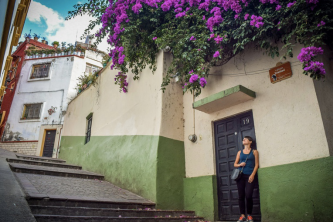
Nestled into a hilly valley, this UNESCO World Heritage Site town is rich in history, local traditions, and color. Truly the best way to get to know Guanajuato is to simply meander through the small alleyways on foot, camera in hand. The further up the slopes you go, the less tourists you'll find, providing you the tranquility needed to fully appreciate the beauty of the city. Bring comfortable shoes and avoid the hassle of finding parking - the major points of interest are all within walking distance of each other.
Don't be afraid to set out alone either. Guanajuato is generally an exceptionally safe city and if you have enough common sense and street smarts, you'll have no problem exploring on your own.
The Diego Rivera Museum
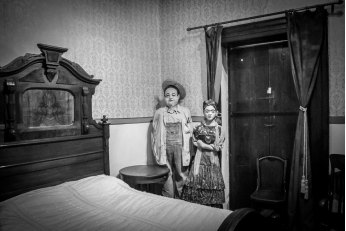
Known primarily for his murals and temperamental relationship with fellow Mexican painter Frida Kahlo, Diego María de la Concepción Juan Nepomuceno Estanislao de la Rivera y Barrientos Acosta y Rodríguez, or simply Diego Rivera, was one of the country's greatest artists. Fans can now visit his birthplace, which has been converted into a museum honoring the famous artist and his work.
Rivera was born in the house in 1886 and lived there until the family moved to Mexico City six years later. The ground floor of the museum is a replica of the Rivera family home, complete with 19th century antiques and furniture. The upper floors contain permanent exhibits of Diego Rivera's sketches and artwork, as well as pieces by other Mexican and international artists.
Entrance to the museum costs $25 pesos per adult.
Museo de las Momias
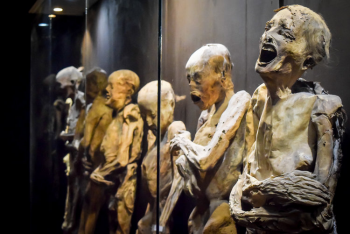
Definitely one of the strangest museums I've ever seen, the Museo de las Momias de Guanajuato houses a collection of naturally mummified bodies that were unearthed from the town cemetery during the 19th and 20th century to make room for more bodies. With an ideal climate and the right soil conditions, Guanajuato provides the perfect environment for natural mummification, although scientists later discovered that a few of the bodies were embalmed prior to burial.
Many of the mummies have grotesque looks of horror on their faces, mouths agape in silent screams, so initially it can be quite unsettling to gaze upon them. The museum also includes a room which has mummified babies, as well as what is believed to be the world's youngest mummified fetus. The children were definitely not easy to look at, but I still found the museum fascinating. Although this is perhaps the quintessential Guanajuato attraction, those too squeamish should probably avoid it.
Entrance to the museo costs $56 pesos for adults and an additional $21 pesos if you wish to take photos.
Callejon del beso
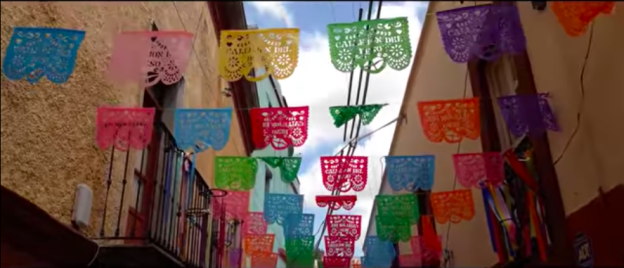
Although there are many variations, Guanajuato has its very own Romeo and Juliet story:
In one incredibly narrow callejón, there are two buildings whose balconies almost touch. According to legend, a young woman from a wealthy family once lived here and one day she fell in love with a common, working man. Her father, hoping to marry his daughter to a rich suitor, discovered their romance and forbade them from seeing each other ever again. Determined not to let their love die, the young man moved into the building next door, and the couple continued their relationship in secret, exchanging kisses from the balconies at nighttime. Inevitably, the woman's father found out, and in a fit of rage, descended upon his daughter stabbing her in the chest with a dagger. The young man, overcome with grief and unable to continue his life alone, eventually committed suicide.
Like many places that feature a tragic love story, Callejón del Beso is now a major, albeit free, tourist attraction in Guanajuato. Sharing a kiss with your significant other on the third step beneath the two balconies is meant to seal your love forever.
6. History and Culture
Pre-Hispanic period
The first known inhabitants of the area were the Otomi, who were then displaced by the Chichimeca. There was Purépecha presence as well due mostly to ancient trading routes. The oldest known name for the area is “Mo-o-ti,” which means “place of metals.” Later, it was called "Paxtitlán" by the Aztecs, which means “place of straw.” The current name of Guanajuato comes from Purépecha kuanhasï juáta (or in older orthography "quanax huato"), which means “frog hill”.
Mining had been done in this area long before the Spanish arrived. Late in the pre-Hispanic period the Aztecs had a presence here, specifically to look for metals to make ornamental objects for their political and religious elite. Some stories from this time state that the area was so rich in minerals that nuggets of gold could be picked up from the ground.
Colonial era

The Spanish found deposits of gold here in the 1540s and soon they sent soldiers and built forts. In 1548, the outpost was formally established with the name of Real de Minas de Guanajuato by viceroy Don Antonio de Mendoza. Despite Chichimeca attacks, the population of the area grew rapidly with the arrival of Spanish and Creole migrants and indigenous and mestizo traders and workers. It was soon declared a town with the name of Santa Fe Real de Minas de Guanajuato, with Preafán de Rivera as mayor. Its first church was consecrated in 1555, and it was named an “alcaldía mayor” in 1574.
Initially, the city was divided into four barrios or neighborhoods called Marfil/Santiago, Tepetapa, Santa Ana and Santa Fe. The last is considered the oldest and is in the current colonia of Pastita. This city was split by a small river that served as a main thoroughfare.[4] The oldest neighborhoods are Rayas y Mellado, Cata, La Valenciana, and Pastita, named after the mines found there.
The very first mineral vein discovered, called San Bernabé, attracted attention not only in New Spain, but in Spain itself. The discovery brought thousands of migrants to the area, which led to the discovery of other deposits, such as at the Rayas mine. The San Bernabé find produced until 1928, when it tapped out. Today, the remains of this mine are found in the small village of La Luz, just outside the city proper.
In 1679, by decree of viceroy of Mexico Fray Payo Enriquez de Rivera, the name was changed to Ciudad de Santa Fe y Real de Minas de Guanajuato (Very Noble and Loyal City of Santa Fe y Real de Minas de Guanajuato). It received an escutcheon in the same year, which is still in use. The city's coat of arms has a gold background with an image of a woman in the center referring to the Holy Faith (Santa Fe). It contains other images such as a seashell supported by two laurel branches, blue ribbon and marble columns. It is topped with the royal crown of Castille and acanthus leaves.
In 1741, the city received the title of “The Most Noble and Loyal City of Santa Fe de Minas de Guanajuato” and became an “intendencia” (province) in 1790 because of the abundance of riches coming from its mines. In the 18th century, it was the world's leading silver extraction center, making it the richest city in Mexico for much of the early colonial period. The production of the La Valenciana mine alone affected the world economy, and made the counts of Valencianas one of the most powerful families in New Spain. The city was one of the richest and most opulent in New Spain in the 18th century. This wealth is manifested in its civil and religious architecture. The colonial architecture includes some of the best Baroque and Churrigueresque examples in the New World—such as the Valenciana, Cata, and La Compañía (Jesuit) Churches, and the Basilica of Our Lady of Guanajuato. Most constructions from this time are of pink or green sandstone. In the churches, the Baroque altars were gilded with gold from local mines. These structures have influenced later buildings throughout central Mexico. According to the UNESCO World Heritage Sites, the La Compañía and La Valenciana churches are considered among the most beautiful examples of Baroque architecture in Central and South America.
Independence
By the end of the 18th century, the lower classes were poor and oppressed despite the great wealth coming out of the mines. One event foreshadowing the Mexican War of Independence was a revolt carried out in the city attacking the heavily militarized Caja Real (building to hold the Crown's share of mining production) to protest the high taxes. One year later there were large protests against the expulsion of the Jesuits.
The War of Independence broke out in the state of Guanajuato in the town of Dolores, when Father Miguel Hidalgo y Costilla shouted the “Grito de Dolores” and raised an insurgent army on September 15 and 16, 1810. This army marched to San Miguel, today San Miguel de Allende, and then on to the city of Guanajuato. Just on the outskirts on September 28, 1810, Hidalgo sent a warning letter to city authorities, but it was ignored. Instead, royalist troops and many of the elite made their stand at the Alhóndiga de Granaditas granary, an imposing building with few windows and thick walls. After entering the city unopposed, Hidalgo decided to attack the granary. This was the first battle against Spanish troops in the war and is popularly called the 'Siege of the Alhondiga'. The insurgents were unable to take the heavily defended building as royalist gunfire kept them from approaching the only entrance until a miner by the name of Juan José de los Reyes Martínez, better known as El Pípila, brilliantly strapped a large flat stone onto his back for protection. Crawling, he carried a flask of tar and a torch. When he reached the wooden doors of the main entrance, he smeared it with the tar and set it on fire. This allowed the insurgents to penetrate the building, defeat the Spanish royalist army and elite, and take over the heavily fortified and defended building. This action is commemorated by a colossal statue of El Pípila on a hill overlooking the city.
After Independence, the province of Guanajuato was made a state, and the city was made its capital in 1824. However, fighting in the state and the rest of the country continued as Liberals, who wanted a Federalist government, fought with Conservatives, who wanted a centralized government under a monarch or dictator. Power in the city and state changed hands between the two factions during much of the 19th century, taking its toll on mining. The city was the provisional capital of the country in 1858 as Liberal president Benito Juárez fought Conservative rebels. In 1863, the French took the city during the French Intervention in Mexico, receiving a visit from the installed Emperor Maximiliano I and his wife, Carlota. French occupation ended in early 1867. The Mexican General Florencio Antillón captured it on January 26, 1868 from the Conservatives.
Mining reactivated around the 1870s due to foreign investments encouraged by the Porfirio Díaz government. During the late 19th and early 20th centuries this renewed economic activity spurred new era Mexican projects such as the Juárez Theater, the Esperanza Dam, the Monumento a la Paz, the Hidalgo Monument and the State Government Palace.
Flooding had been a serious problem through most of the city's history, due to the area's steep compact hillsides. In 1760 and 1780 two major floods nearly wiped it out. This spurred construction of large ditches and tunnels to contain and divert overflows during the rainy season. These eventually crisscrossed a large part of the city. Dam construction in the 1960s brought the flooding under control, and many of the ditches and tunnels were converted into underground roadways.
The first Festival Internacional Cervantino was held in 1972. The historic city center was declared a World Heritage Site in 1988.
7. Other Information of Interest
The world-famous Festival Internacional Cervantino is an annual cultural event, held in the city of Guanajuato, which sponsors a large number of artistic and cultural events with artists invited from Mexico and all over the world. The event is named in honor of Miguel de Cervantes, author of Don Quixote. The festival began in 1972, as short plays performed by University of Guanajuato students based on the works of Cervantes. In 2010, special guests included the state of Querétaro and the country of Colombia. The 2010 edition of the festival included performers such as Tangokineses from Argentina and Cumbia Cienaguera from Colombia. In total there were 424 events over 26 days.
The festival hosts events such as opera, theater productions, film showings, art exhibitions, academic conferences and talks, concerts and dance recitals. The performances occur in 70 venues over most of the month of October. Events are held throughout the city, with some in other locations such as Mexico City, Guadalajara and San Miguel de Allende. The most important venue in Guanajuato for the festival is Juárez Theater, which is located close to Jardín de la Unión (Union Garden). Other important venues in the city are Teatro Principal, Cervantes Theater and facilities of the University of Guanajuato. Events are also held in area churches, plazas and even on the streets. Festival International Cervantino Callejero is a parallel event sponsored by Centro Libre de Experimentación Teatral y Artística (CLETA). In 2010, this event featured 300 performances with social themes. This annual event was begun in 1975, in part inspired by The Beatles’ Abbey Road album cover.
The underground tunnels of Guanajuato
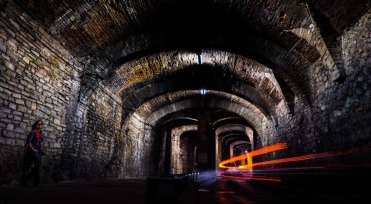
The Guanajuato underground tunnels are a network of wide channels that help lead traffic away from the city center. These tunnels have different layer crossroads and underground junctions. The tunnels are used for traffic which is heading in an eastwards direction. The westward direction passes through the center of Guanajuato. All of the tunnels have footpaths and even some of the bus stops are subterranean.
The tunnel system of Guanajuato was built to prevent flooding. Túnel La Galereña is the longest tunnel of this network and was excavated in the early 19th century to lead the Guanajuato River away from the center of the city. In 1960s the old river tunnels were strengthened, as they were in a bad condition and showed signs of collapse and subsidence. After the reconstruction, they were converted into a road tunnel. The first road journey was in 1961. But the old tunnels were of a suitable size for cars, medium-sized bus and vans but prevented larger transport getting into the city. A second tunnel was dug during the late 1960s, which diverted the river much deeper. Several additional tunnels were excavated during the 1990s.
8. Contact Information
City Mayor: Mario Alejandro Navarro Saldaña
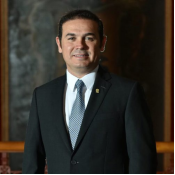
Contact number: +52 (473) 732 1213
Govt. Office Address: Plaza de la Paz No. 12, Colonia Centro, Guanajuato, Gto., 36000
Facebook: https://www.facebook.com/GuanajuatoGob
Twitter: https://twitter.com/GobSanCristobal
E-mail: navarro@guanajuatocapital.gob.mx
Website: http://www.guanajuatocapital.gob.mx/9
